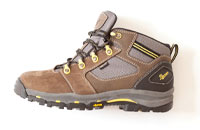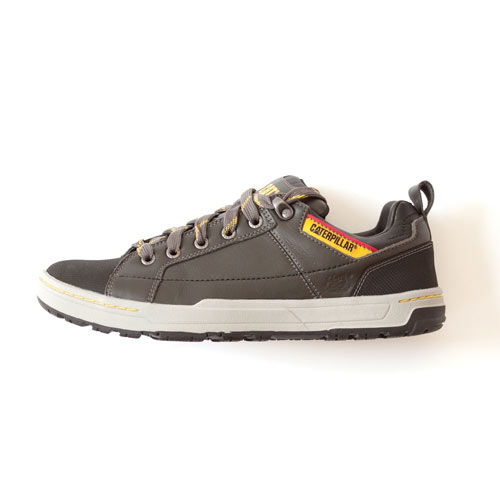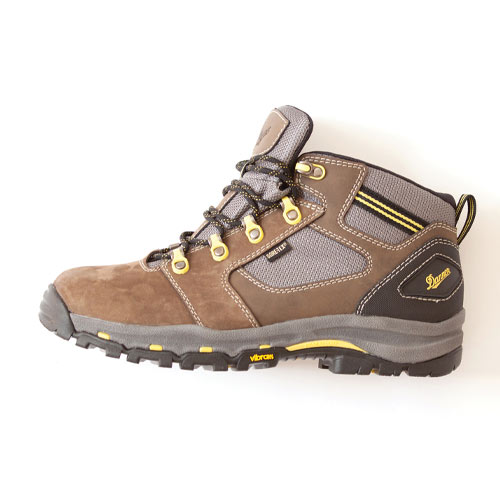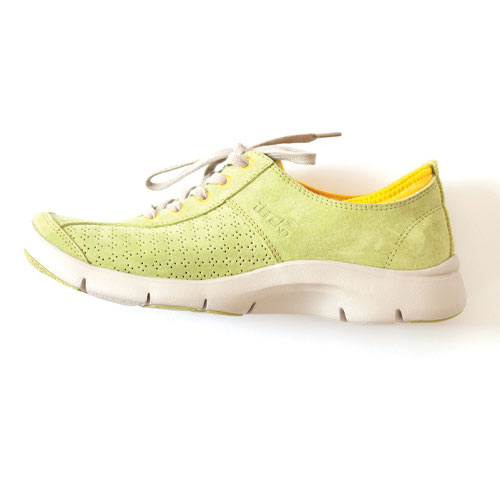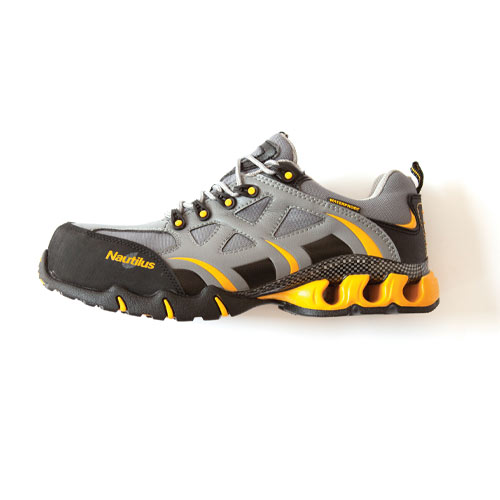Occupational brands are raising the comfort bar and taking a load off to help get the job done.
By Lyndsay McGregor
If it worked well for running brands, then why can’t it work for work brands? It wasn’t too long ago that a running shoe was loaded up with bells and whistles—to a point of over-construction that saw layers of cushioning and stability technologies distancing the runner from the road as much as possible. But then along came the barefoot movement and the belief that less is more beneficial when it comes to design—be it less less structure and less weight. Minimalism is the new black, and consumers—as evidenced by sales of the popular Nike Free shoes—are gobbling it up.
Now that minimalism has gone mainstream and is not something as foreign in concept as a pair of FiveFingers once was, work brands are embracing the design premise to a greater degree. For starters, many of those entering the work force have grown up wearing sneakers and are accustomed to lightweight constructions and the perceived benefits of cushioning technologies. Moreover, there are many similarities between the needs of an athlete and a worker: both demand performance, comfort, durability, cushioning and protection out of footwear. It’s a critical piece of equipment. And then there’s the competitive factor: The advances in athletic technologies and design have helped spark innovation in the work industry. Nobody making performance footwear ever wants its products to be relegated to the scrap heap of outmoded design. As such, work boots are becoming lighter and more seamless than ever before. And what’s on tap for next spring is no exception.
“Consumer’s expectations of how much shoes should weigh are evolving into lighter and lighter territory,“ confirms Roger Huard, Wolverine’s vice president of product development. “And if your shoes aren’t comfortable, they’re not going to go anywhere.” Indeed, expectations have never been greater and the words on everybody’s lips are “lightweight,” “durable” and “comfortable.”
Jeremy Stark, vice president of sales for Rocky’s Work & Duty division, is excited to see work brands push the innovation and technology envelope. “I think the work segment is approaching innovation in a more intelligent manner than in the past, focusing on benefits most important to today’s consumer and occupational demands,” he notes. Jared Oviatt, vice president of sales at Georgia Boot, a division of Rocky Brands, compares it to the athletic industry’s technological advances in the late ’90s and early ’00s, adding that those advances recently seen in work are designed to “meet specific needs.”
But it’s not simply a case of keeping up with the Joneses; consumers are demanding it. “The market has adjusted from an age perspective so we look at the up-and-coming work force that’s entering the industry,” says Karry Johnson, national sales manager for Caterpillar, pointing to the influx of entry-level workers who grew up in sneakers. LaCrosse Footwear Product Line Manager Hans Albing agrees: “There’s a lot of design going towards meeting [the new workforce’s] needs as opposed to what they used to wear in that industry. Now they want athletically-inspired constructions.”
And while execs and designers are quick to note that minimalism is an obvious misnomer when it comes to work boots, footwear that allows the worker to feel as comfortable at the end of the day as it does at the beginning is a bandwagon everyone can hop on. This means engineering product with deep cushioned insoles, gels, extra arch support and reinforced heels to protect the foot and absorb the pounding of a full day’s work. “There are more components, more applications and more performance requirements to consider when developing the next generation of lighter weight work product versus athletic footwear,” says Albing. “Both categories innovate in materials and design for performance, but work product must also be durable enough to last in harsh conditions and meet strict safety needs for a wide variety of industries.”
Safety First
For Caterpillar, a licensee of Wolverine Worldwide, this means working closely with Biomechanics Evaluation Laboratory at nearby Michigan State University. “At the end of the day our promise is validated through testing,” Johnson attests, pointing out that in the past two years, the brand’s athletic-like Argon shoe has become a bestseller, with its full-grain leather upper, nylon mesh lining, slip-resistant rubber outsole and composite safety toe. “We do a lot of field testing with delivery individuals and plant workers before the shoes even hit the market to make sure they’re comfortable and will hold up,” he reveals. For spring, the brand is updating its T870 silhouette: Aesthetically similar to a hiking boot, it’s lightweight and slip-resistant with a leather and mesh combination upper and Ergo technology for enhanced cushioning, support and all-day comfort. “We have an SRX compound that we inject into the rubber to make it super slip-resistant,” he adds. “It’s the best of work with the best of athletic—a hybrid.”
Oviatt likens Georgia Boot’s field-testing to athletic companies using their network of professional athletes to refine new product introductions. “The only difference being a potential product failure has real consequences to the person testing the product,” he notes. While purpose-driven product like Diamond Trax (a slip-resistant outsole that gets better with age) and Comfort Core (an energy return heel plug) continues to pull people in, Georgia Boot’s Thermal Tech—a line created specifically for those working in aluminum plants and steel mills—is the brand’s big push for spring. “We developed a rubber outsole that will exceed a 500-degree temperature and we stitched the entire product with Kevlar (fire-retardant thread) so workers don’t have to worry about the boot failing under high heat conditions.”
At LaCrosse, boots are put through their paces during four months of field tests in their respective work environments. “Our footwear has to stand up to some of the harshest environments for long hours,” Albing says, noting that the company’s Danner and LaCrosse brands are tested to ensure all linings, waterproof membranes and outsoles deliver. “All work product has to pass certain ASTM, SATRA and CSA standards specifically for slip-resistance, safety toe and metatarsal guards.” For spring, Danner is introducing the Vicious, a hiker-inspired boot with a more anatomical fit and a wider non-metallic toe box, while LaCrosse continues to improve its rubber work line, using dipped neoprene technology designed for the hydraulic fracturing industry. “We’ve incorporated all the feedback we received over the years and added new components like a molded Vibram rubber toe, heel and vamp area,” he reveals.
Meanwhile Wolverine, whose patented ICS comfort dial allows the wearer to adjust the level of support, is extending its Peak AG series, taking the idea of lightweight technology and building it into a boot suitable for heavy industrial work, with a 360-degree security stitch and direct attach construction to ensure double protection for the outsole. But, as Huard points out, even with all these new bells and whistles, work boots are not fashion accessories; they’re something that workers need. “Part of this emphasis towards durable footwear is because people are more careful about what they’re going to spend their money on,” he says.
Need, Not Want
Christopher Scott, industrial product lead at Dr. Martens, says that while consumers are asking for lighter, flexible footwear, they still want durability and adds, “[They’re] looking for multi-purpose footwear. They want something they can wear to work, that’s functional and that they can wear out afterwards. They want value.” Ann Dittrich, creative director at Dansko, agrees. “We never think of our shoes worn for service as being any better or different than lifestyle,” she says. It’s little wonder that healthcare professionals, teachers and others who spend the majority of their day in motion and on their feet are Dansko fanatics. “Customers deserve and demand the comfort, support and the performance of [the brand] in all of their end uses.”
“For the worker on the job site, we have to balance safety innovations with performance innovations,” says Johnson. “The average worker buys far fewer pairs of work boots than an athletic consumer buys sneakers, so if you let him or her down once, they may not come back to your brand.” Caterpillar must be doing something right in this regard: The brand’s topline sales through 2011 grew 35 percent. “The consumer knows our brand is durable and now that we’ve built in these comfort factors, he or she is willing to spend more,” he says.
Oviatt shares this sentiment, adding that that while people are looking for more bang for their buck, they’re not willing to compromise on safety. “A year and a half ago people compromised on not replacing their product as much as they needed to but now I see them putting more money into their footwear,” he says. More to the point, consumers are smarter. “It’s no longer sufficient to differentiate our products by style alone or following a trend in materials or branded components,” he says. “In order to gain the loyalty and trust of work consumers you need to deliver a clear message and exceed their expectations on all fronts.”
The same goes for retailers: Brand recognition is no longer enough and a slew of new technologies and promises mean squat to consumers without competent sales pitches to back them up. “Make sure your employees get personal ‘feet-on’ experience with the products that they sell,” advises Oviatt. Because occupational footwear is now so packed with features and benefits, shoppers want to know in the quickest and easiest way what’s on offer. As Albing points out, “Guys know what their job site requires and they’re going to want to know if the product fits that requirement. Whether it’s on-product labeling or a quick guide, they want to know if it’s the shoe they need.” And if you don’t have it, someone else probably will. “First and foremost you need to have inventory,” says Johnson. “Joe Six Pack doesn’t pre-plan and rarely shops online. “If a customer walks in and you don’t have their size, they’re going to walk right out and into the next store.”
One challenge now facing manufacturers is how to make their product stand out. From similar constructions to typical black, brown or honey nubuck options, work boots and shoes tend to look the same regardless of season or brand. “There’s a wall of 50 styles of work boots and we have four styles on the wall: We want to knock our competitors off that wall,” Johnson says, adding that Caterpillar’s women’s business is growing at a good clip. One way they’re capitalizing on this growth is by offering styles that aren’t simply takedowns of men’s. “We’re trying to infuse more colors and make them even more lightweight,” he says.
According to some execs, another key factor to the category’s success at retail is down to an increasing number of weighty boots stomping their way down the runway. Call it blue-collar chic, but menswear designers like Adam Kimmel, Dolce & Gabbana and Giorgio Armani, to name but a few, all displayed some serious lug south of those pants hems in their Fall ’12 showcases. If that’s not enough proof, Huard confirms that Wolverine’s 1000 Mile label—premium heritage styles featuring Horween leathers, stacked leather outsoles, Vibram soles and a Goodyear welt construction—tripled its sales in 2011.
And though many believe domestic growth of the category going forward rests squarely on market share, Oviatt believes international growth is possible as well. “Even though the market itself is not expanding, the world market as a whole—as Asia and Eastern Europe continue to develop—is, so there’s a larger market that a lot of brands have potential access to.” Stark, coming off a 300 percent leap in Fall ’12 bookings for Rocky, remains optimistic: “As long as we keep identifying a unique niche, growth will surely follow,” he maintains.
But no matter the color, silhouette or technology, it’s comfort and safety that matter most to occupa-tional customers. “It’s about focusing on the best product at the best price. We need to really look at what consumers need and how we can best serve them,” Oviatt insists. And remember, he adds, a work consumer is a buyer, not a shopper.

